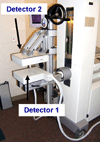Scientific Impact Recognition Award: Molecular breast imaging: a review of the Mayo Clinic experience
- PMID: 18723155
- PMCID: PMC2603338
- DOI: 10.1016/j.amjsurg.2008.06.005
Scientific Impact Recognition Award: Molecular breast imaging: a review of the Mayo Clinic experience
Abstract
Background: Molecular breast imaging (MBI) depicts functional uptake of targeted radiotracers in the breast using dedicated gamma cameras.
Methods: MBI studies were performed under several institutional protocols evaluating the use of MBI in screening and diagnosis.
Results: By using a single-head system, sensitivity for breast cancer detection was 85% (57 of 67) overall and 29% for tumors 5 mm or less in diameter. Sensitivity improved to 91% (117 of 128) overall and 69% for tumors 5 mm or less using a dual-head system. In 650 high-risk patients undergoing breast cancer screening, MBI detected 7 cancers, 5 of which were missed on mammography. In 24 of 149 (16%) breast cancer patients MBI detected additional disease not seen on mammography. The sensitivity of MBI was 88% (83 of 94) for invasive ductal carcinoma, 79% (23 of 29) for invasive lobular carcinoma, and 89% (25 of 28) for ductal carcinoma in situ.
Conclusions: MBI can detect invasive ductal carcinoma, ductal carcinoma in situ, and invasive lobular carcinoma. It has a promising role in evaluating the extent of disease and multifocal disease in the breast for surgical treatment planning.
Figures




References
-
- Jemal A, Siegel R, Ward E, et al. Cancer statistics, 2008. CA Cancer J Clin. 2008;58:71–96. - PubMed
-
- Kerlikowske K, Grady D, Rubin SM, Sandrock C, Ernster VL. Efficacy of screening mammography: a meta-analysis. JAMA. 1995;273:149–154. - PubMed
-
- Tabar L, Vitak B, Chen HH, Yen MF, Duffy SW, Smith RA. Beyond randomized controlled trials: organized mammographic screening substantially reduces breast carcinoma mortality. Cancer. 2001;91(9):1724–1731. - PubMed
-
- Humphrey LL, Helfand M, Chan BKS, Woolf SH. Breast cancer screening: a summary of the evidence for the U.S. Preventive Services Task Force. Ann Intern Med. 2002;137:347–360. - PubMed
-
- Carney PA, Miglioretti DL, Yankaskas BC, et al. Individual and combined effects of age, breast density, and hormone replacement therapy use on the accuracy of screening mammography. Ann Intern Med. 2003;138:168–175. - PubMed
Publication types
MeSH terms
Substances
Grants and funding
LinkOut - more resources
Full Text Sources
Medical

